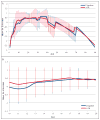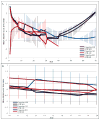Adolescent brain development and depression: A case for the importance of connectivity of the anterior cingulate cortex
- PMID: 27461914
- PMCID: PMC5074859
- DOI: 10.1016/j.neubiorev.2016.07.024
Adolescent brain development and depression: A case for the importance of connectivity of the anterior cingulate cortex
Abstract
We propose that structural and functional connectivity of the anterior cingulate cortex (ACC) represents a critical component of adolescent developmental psychopathology. We hypothesize that connectivity of the ACC, a hub for integrating cognitive, affective, and social information to guide self-regulation across domains, supports adaptive development of self-regulation during adolescence and that, conversely, disrupted maturation of ACC connectivity contributes to the development of depression. To integrate findings on typical development, we report results of a meta-analysis of diffusion imaging findings of typical adolescent development of the cingulum and anterior thalamic radiations, the tracts most relevant to ACC connectivity, and provide a critical review of the literature on ACC functional connectivity. Finally, we review the evidence for altered structural and functional connectivity in adolescents with depression. Although the evidence for our claim is persuasive, a more comprehensive understanding of the ACC's role depends upon future investigations with sophisticated modeling of networks, prospective and longitudinal designs, and examination of structure-function associations.
Keywords: Adolescence; Affect regulation; Anterior cingulate cortex; Connectivity; Depression; Development.
Copyright © 2016 Elsevier Ltd. All rights reserved.
Figures




References
-
- Andersen SL. Trajectories of brain development: point of vulnerability or window of opportunity? Neurosci Biobehav Rev. 2003;27:3–18. - PubMed
-
- Baeken C, Marinazzo D, Wu GR, Van Schuerbeek P, De Mey J, Marchetti I, Vanderhasselt MA, Remue J, Luypaert R, De Raedt R. Accelerated HF-rTMS in treatment-resistant unipolar depression: Insights from subgenual anterior cingulate functional connectivity. World J Biol Psychiatry. 2014;15:286–297. - PubMed
-
- Barrett J, Della-Maggiore V, Chouinard PA, Paus T. Mechanisms of action underlying the effect of repetitive transcranial magnetic stimulation on mood: behavioral and brain imaging studies. Neuropsychopharmacology. 2004;29:1172–1189. - PubMed
-
- Beaulieu C. The basis of anisotropic water diffusion in the nervous system - a technical review. NMR Biomed. 2002;15:435–455. - PubMed
Publication types
MeSH terms
Grants and funding
LinkOut - more resources
Full Text Sources
Other Literature Sources
Medical

